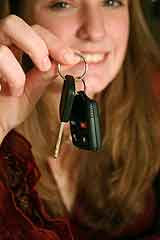Anxious parents across the country are busy preparing a homecoming for their college-age kids, many of whom will be making their first road trip home from campus this holiday season. But how concerned should parents be about their teens on the road?

According to an online survey of teen drivers sponsored by Bridgestone Firestone North American Tire, LLC, the answer depends on parents¹ involvement in ensuring their children are safe drivers. Most teen drivers (63 percent) credit their parents as the source most responsible for teaching them driving skills. (Thankfully, just 4 percent of teens say they learned to drive from their friends.) So parents are in a unique position to encourage their teens to practice safe driving habits.
The survey found that one of the simplest safety behaviors in vehicles, namely wearing a seatbelt, seems to be indicative of other safe behaviors in teen driving. Nineteen percent of teen drivers who said they always wear their seatbelts also reported having been in an accident or receiving a moving violation. That incidence rate jumped to 55 percent for those teens who only ³occasionally² wear their seatbelts. As the National Highway Transportation Safety Administration attributes the recent drop in highway fatalities to seatbelt usage, this simple safety behavior is essential to keep teens safe on the roads this holiday season.
Many teens will drive home from college with a friend, and the survey also asked respondents to rate their peers¹ driving habits. It turns out that of the teens surveyed, the older they are and the more driving experience they gain, the more they said their peers are not very safe drivers. More than half (54 percent) of 19-year-olds surveyed felt that teens are generally not safe drivers, compared with 35 percent of 16-year-olds who felt the same way.
Overall, the surveyed teens said they feel very well-educated about driving safety and regulations. But one area about which teens feel overwhelmingly ill-informed relates to proper car maintenance. Ninety-nine percent of all teens surveyed said they feel well informed about driver safety, and 98 percent feel well informed about traffic laws. However, when it comes to properly maintaining a vehicle, only 23 percent feel very well informed.
Before the holiday road trips begin, here are a few seasonal safe-driving tips that parents can pass along to their teens.
Practice safe driving habits. Increase distance between cars, two hands on the wheel, look ahead and focus where you want to go.
Check tire air pressure weekly in colder weather. As outside temperatures drop, air in tires contracts. This reduces the tire air pressure one pound per square inch for each 10-degree drop in temperature, so check your inflation pressure more frequently during the cold months. Under-inflation will lessen tires¹ gripping action because the tread will not meet the road surface as it is designed to do.
If you get stuck in the snow, don¹t spin your tires. This can overheat them. First check your owner¹s manual and follow any specific instructions it provides for this situation. If no instructions are given, rock your vehicle back and forth gently by driving forwards and in reverse over increasing distances.
Avoid abrupt movements when braking, accelerating or turning. If your vehicle starts to hydroplane, gently take your foot off the accelerator and try to regain feeling of the road. Do not abruptly press on the brake pedal, or you could lose control of the car.
Do not pump the brakes on a vehicle with an Anti-lock Brake System (ABS). You should never pump the brake pedal on a car with ABS, since the system itself pumps the brakes automatically. All you need to do is apply firm and continuous pressure to the brake pedal to activate the ABS operation.
Use your headlights. Headlights will help other drivers see you in inclement weather. In many states, headlight use is required when drivers use their windshield wipers.
Always wear your seatbelt. It really can save your life.
The data cited in this article is based on the findings of an online survey among 800 teen drivers nationwide, conducted on behalf of Bridgestone Firestone North American Tire, LLC (BFNT) by Charlton Research Company.




